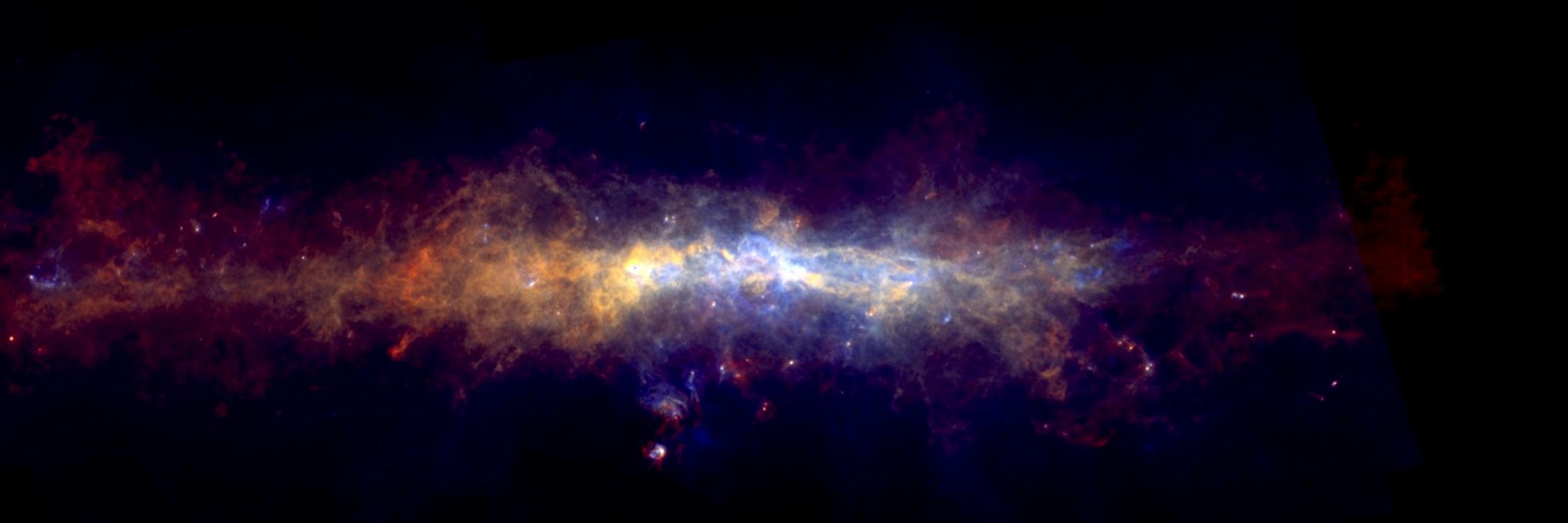
Dr./Prof. Cara Battersby
@battersbot.bsky.social
Astrophysicist, educator, and mama who likes to play outside. Low-key vibes, fancy degrees. I believe that which unites us is greater than that which divides us, so let's find common ground. Associate Professor at UConn, views my own.
Nervousness aside, I hope I did justice to the amazing science being done by the folks at the Milky Way Laboratory (battersby.physics.uconn.edu/our-team/). I'll share the video when it's published and in the meantime, check out and consider supporting Universe Today (www.patreon.com/cw/universet...)

Team | Professor Cara Battersby
The Milky Way Laboratory Research Team Meet the people who make the science happen! Faculty: Dr. Cara Battersby is the PI and founder of the Milky Way Labor ...
battersby.physics.uconn.edu
May 29, 2025 at 8:56 PM
Nervousness aside, I hope I did justice to the amazing science being done by the folks at the Milky Way Laboratory (battersby.physics.uconn.edu/our-team/). I'll share the video when it's published and in the meantime, check out and consider supporting Universe Today (www.patreon.com/cw/universet...)
3) After the fact, I kept thinking of how I could have said something better, an analogy I could have brought up, someone's work I should have mentioned, etc. But I'm pretty sure if you wait to put yourself out there til you are perfect... it won't happen. So, deep breath, leap of faith, go!
May 29, 2025 at 8:56 PM
3) After the fact, I kept thinking of how I could have said something better, an analogy I could have brought up, someone's work I should have mentioned, etc. But I'm pretty sure if you wait to put yourself out there til you are perfect... it won't happen. So, deep breath, leap of faith, go!
2) I was SO much more nervous than I expected. I'm used to talking to auditoriums full of people about astronomy, but I was definitely feeling intimidated and majorly starstruck. Feeling in awe of the folks who do this on the reg. how. do. you. do. it??
May 29, 2025 at 8:56 PM
2) I was SO much more nervous than I expected. I'm used to talking to auditoriums full of people about astronomy, but I was definitely feeling intimidated and majorly starstruck. Feeling in awe of the folks who do this on the reg. how. do. you. do. it??
1) Fraser Cain and the team at www.universetoday.com are *awesome*. I've been a fan for a long time, but the work they are doing is more important than ever. High quality, engaging astronomy journalism - now with no ads 🤯. If you're not a fan already GET. ON. THAT. TRAIN.

Home
www.universetoday.com
May 29, 2025 at 8:56 PM
1) Fraser Cain and the team at www.universetoday.com are *awesome*. I've been a fan for a long time, but the work they are doing is more important than ever. High quality, engaging astronomy journalism - now with no ads 🤯. If you're not a fan already GET. ON. THAT. TRAIN.
The highly filamentary nature of dust and gas in the interstellar medium is a huge topic of discussion and debate, so good observation! Depending on the scale and environment it could be from gravitational flows, turbulence, magnetic fields, some combination or something else entirely!
May 21, 2025 at 5:53 PM
The highly filamentary nature of dust and gas in the interstellar medium is a huge topic of discussion and debate, so good observation! Depending on the scale and environment it could be from gravitational flows, turbulence, magnetic fields, some combination or something else entirely!
Perspective! The Sun (and therefore the Earth and all of us!) are deep in the disk of our Milky Way Galaxy, so we see it "edge-on" when we look out. To get a "top-down" perspective you'd need to send a spacecraft several thousand light years above the plane - not practical now or probably ever!
May 21, 2025 at 5:51 PM
Perspective! The Sun (and therefore the Earth and all of us!) are deep in the disk of our Milky Way Galaxy, so we see it "edge-on" when we look out. To get a "top-down" perspective you'd need to send a spacecraft several thousand light years above the plane - not practical now or probably ever!
Not a dumb question at all! Being in the middle of all the gas and dust of the Milky Way is a big challenge! Most surveys of galaxies just look ABOVE the Galactic plane to avoid it. But I want to understand all the gas and dust of the Galaxy, so I stare straight at it 😜
May 20, 2025 at 6:41 PM
Not a dumb question at all! Being in the middle of all the gas and dust of the Milky Way is a big challenge! Most surveys of galaxies just look ABOVE the Galactic plane to avoid it. But I want to understand all the gas and dust of the Galaxy, so I stare straight at it 😜
Lol, I've already decided we just have to embrace the typos, otherwise, it will drive us crazy 😆
May 20, 2025 at 6:40 PM
Lol, I've already decided we just have to embrace the typos, otherwise, it will drive us crazy 😆
Yay, thank you @sarahkendrew.bsky.social ❤️🎉
May 20, 2025 at 6:37 PM
Yay, thank you @sarahkendrew.bsky.social ❤️🎉
to be fair, i literally joined yesterday, but your support is so greatly appreciated 🙏❤️
May 20, 2025 at 6:37 PM
to be fair, i literally joined yesterday, but your support is so greatly appreciated 🙏❤️
Love it!!! There is SO SO much more to be seen in the Galactic Center, as perfectly evidenced by the combination with that phenomenal MeerKAT data 😍🤩
May 20, 2025 at 6:36 PM
Love it!!! There is SO SO much more to be seen in the Galactic Center, as perfectly evidenced by the combination with that phenomenal MeerKAT data 😍🤩
haha, yes true! But that's historically been the "universe" that we could access at high spatial resolution. That's changing with new facilities though!
May 20, 2025 at 6:34 PM
haha, yes true! But that's historically been the "universe" that we could access at high spatial resolution. That's changing with new facilities though!
I do astrophysics research with an awesome group of students at the Milky Way Lab (battersby.physics.uconn.edu) at UConn and would love to be able to share our most exciting results!

Home | Professor Cara Battersby
Contact InformationEmail: [email protected] Office: Gant South S-113F Virtual Office: https://uconn-cmr.webex.com/meet/cab16109 Phone: (860 ) 486-398 ...
battersby.physics.uconn.edu
May 20, 2025 at 6:32 PM
I do astrophysics research with an awesome group of students at the Milky Way Lab (battersby.physics.uconn.edu) at UConn and would love to be able to share our most exciting results!
Thank you! And yes - how big the universe and its largest structures are is absolutely mind-blowing!
May 20, 2025 at 6:31 PM
Thank you! And yes - how big the universe and its largest structures are is absolutely mind-blowing!
Yes exactly! What I wouldn't give for the top-down view... 😮🤩
May 20, 2025 at 6:30 PM
Yes exactly! What I wouldn't give for the top-down view... 😮🤩
Great thanks! @bot.astronomy.blue
signup
signup
May 20, 2025 at 6:29 PM
Great thanks! @bot.astronomy.blue
signup
signup
By combining with other datasets and cutting edge simulations (see our 3-D CMZ page! centralmolecularzone.github.io/3D_CMZ/) we are creating a top-down model of our Galaxy's center, allowing us to trace gas flows from the disk of the Galaxy, all the way to its center.
3-D CMZ
Unveiling the Structure of our Galaxy’s Central Molecular Zone
centralmolecularzone.github.io
May 19, 2025 at 5:51 PM
By combining with other datasets and cutting edge simulations (see our 3-D CMZ page! centralmolecularzone.github.io/3D_CMZ/) we are creating a top-down model of our Galaxy's center, allowing us to trace gas flows from the disk of the Galaxy, all the way to its center.
By systematically studying light from the entire inner Milky Way, we showed (in Battersby et al. 2025a: ui.adsabs.harvard.edu/abs/2025ApJ....) that the CMZ is separate and unique in our Galaxy and may be bigger than previously thought.
3D CMZ. I. Central Molecular Zone Overview
The Central Molecular Zone (CMZ) is the largest reservoir of dense molecular gas in the Galaxy and is heavily obscured in the optical and near-IR. We present an overview of the far-IR dust continuum, ...
ui.adsabs.harvard.edu
May 19, 2025 at 5:51 PM
By systematically studying light from the entire inner Milky Way, we showed (in Battersby et al. 2025a: ui.adsabs.harvard.edu/abs/2025ApJ....) that the CMZ is separate and unique in our Galaxy and may be bigger than previously thought.
This image shows three far-infrared wavelengths from the Herschel space observatory (350, 160, and 70 micron) towards the inner 7 degrees of our Galaxy. The "figure 8" shape near the very center is our Central Molecular Zone (CMZ), the site of the most extreme star formation in the Galaxy.
May 19, 2025 at 5:51 PM
This image shows three far-infrared wavelengths from the Herschel space observatory (350, 160, and 70 micron) towards the inner 7 degrees of our Galaxy. The "figure 8" shape near the very center is our Central Molecular Zone (CMZ), the site of the most extreme star formation in the Galaxy.

